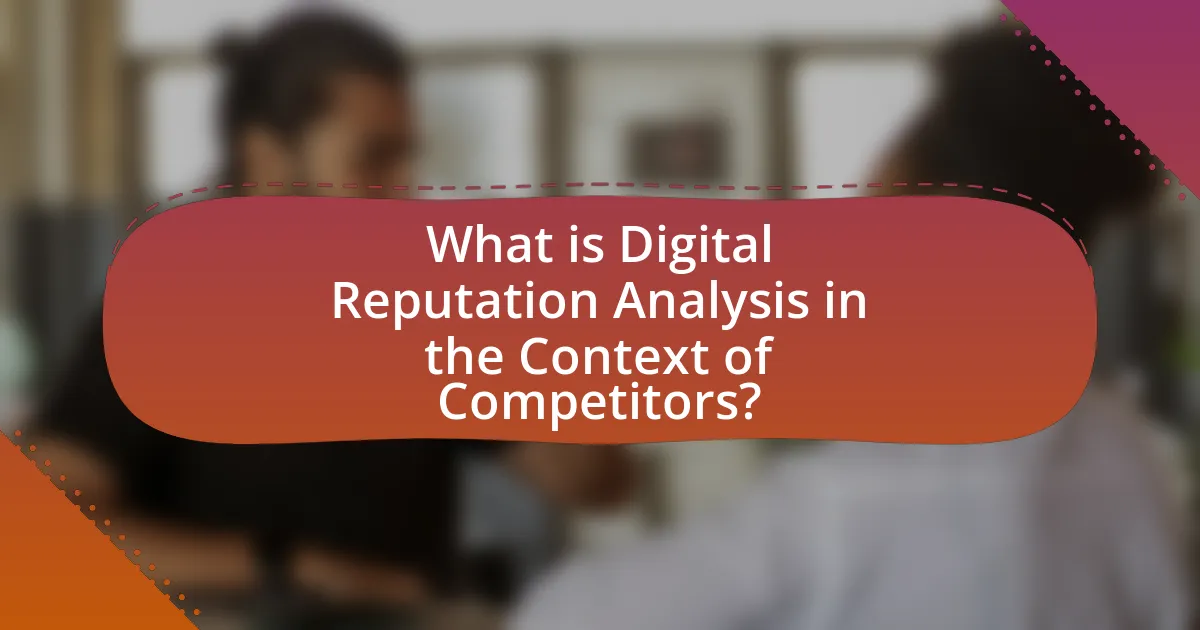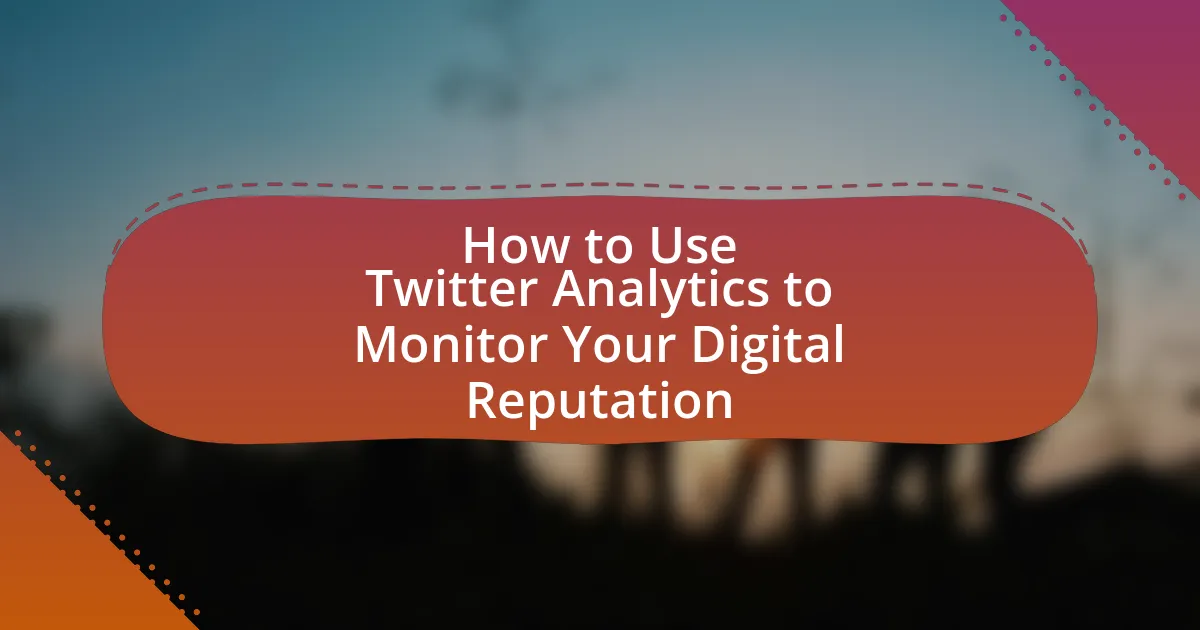Digital Reputation Analysis in the context of competitors involves evaluating how competitors are perceived online, particularly through platforms like Twitter. This article outlines the significance of monitoring Twitter interactions, sentiment, and engagement metrics to gain insights into competitors’ strengths and weaknesses. It details specific metrics for analysis, such as engagement rates and mention volume, and discusses the importance of understanding competitors’ reputations for strategic business decisions. Additionally, the article explores Twitter Block Tracking as a method to identify competitors’ perceived threats and offers best practices for ongoing reputation monitoring, emphasizing ethical considerations and common pitfalls to avoid in competitor analysis.

What is Digital Reputation Analysis in the Context of Competitors?
Digital Reputation Analysis in the context of competitors refers to the systematic evaluation of how a competitor is perceived online, particularly through social media platforms like Twitter. This analysis involves monitoring mentions, sentiment, and engagement related to a competitor’s brand, products, or services to understand their public image and customer perceptions. For instance, tools that track Twitter interactions can reveal how often a competitor is discussed positively or negatively, providing insights into their strengths and weaknesses in the market. This data can be validated by examining metrics such as engagement rates, follower growth, and sentiment analysis, which collectively inform strategic decisions for improving one’s own digital reputation in comparison to competitors.
How does Twitter play a role in analyzing digital reputation?
Twitter serves as a critical platform for analyzing digital reputation by providing real-time insights into public sentiment and engagement regarding individuals or brands. The platform’s vast user base generates a wealth of data through tweets, retweets, likes, and replies, which can be analyzed to gauge public perception. For instance, sentiment analysis tools can process this data to identify positive, negative, or neutral sentiments associated with a brand, allowing businesses to understand their reputation in the digital landscape. Additionally, Twitter’s trending topics and hashtags can reveal emerging issues or conversations that may impact a brand’s reputation, enabling timely responses and strategic adjustments.
What specific metrics can be tracked on Twitter for reputation analysis?
The specific metrics that can be tracked on Twitter for reputation analysis include engagement rate, sentiment analysis, follower growth, mention volume, and share of voice. Engagement rate measures interactions (likes, retweets, replies) relative to impressions, providing insight into how content resonates with the audience. Sentiment analysis evaluates the emotional tone of mentions, indicating public perception. Follower growth tracks changes in audience size over time, reflecting brand interest. Mention volume counts how often a brand is referenced, highlighting visibility and conversation levels. Share of voice compares a brand’s mentions to competitors, assessing market presence. These metrics collectively offer a comprehensive view of a brand’s reputation on Twitter.
How do Twitter interactions reflect a competitor’s digital reputation?
Twitter interactions serve as a direct indicator of a competitor’s digital reputation by showcasing public engagement levels, sentiment, and audience perception. High volumes of positive interactions, such as likes, retweets, and favorable comments, suggest a strong and favorable digital reputation, while negative interactions, including complaints or derogatory remarks, can indicate reputational issues. For instance, a study by the Pew Research Center found that 64% of Twitter users engage with brands, and the nature of these interactions can significantly influence public perception. Thus, analyzing the sentiment and frequency of Twitter interactions provides valuable insights into how a competitor is viewed in the digital landscape.
Why is it important to analyze competitors’ digital reputation?
Analyzing competitors’ digital reputation is crucial for understanding market positioning and consumer perception. By evaluating how competitors are perceived online, businesses can identify strengths and weaknesses in their own strategies. For instance, a study by Sprout Social found that 70% of consumers are influenced by online reviews, highlighting the impact of digital reputation on purchasing decisions. This analysis enables companies to adapt their marketing strategies, improve customer engagement, and enhance their own reputation in response to competitor insights.
What insights can be gained from understanding competitors’ reputations?
Understanding competitors’ reputations provides insights into market positioning, customer perceptions, and potential areas for differentiation. By analyzing competitors’ reputations, businesses can identify strengths and weaknesses in their offerings compared to others in the industry. For instance, if a competitor is praised for exceptional customer service, a business can focus on enhancing its own customer support to gain a competitive edge. Additionally, insights into negative feedback received by competitors can inform strategies to avoid similar pitfalls and improve overall brand perception. This approach is supported by data from various market analyses, which indicate that companies that actively monitor and respond to competitors’ reputations often see improved customer loyalty and market share.
How can digital reputation impact business strategy?
Digital reputation significantly impacts business strategy by influencing customer trust and brand perception. A positive digital reputation can lead to increased customer loyalty and higher sales, as studies show that 84% of consumers trust online reviews as much as personal recommendations. Conversely, a negative digital reputation can deter potential customers and harm sales, with 70% of consumers stating they would avoid a business with negative online reviews. Therefore, businesses must actively manage their digital reputation to align their strategies with customer expectations and market demands.
![]()
How to Use Twitter Block Tracking for Competitor Analysis?
To use Twitter block tracking for competitor analysis, monitor the accounts that your competitors block on Twitter to gain insights into their perceived threats and challenges. By identifying these blocked accounts, you can analyze the nature of their interactions, the type of content they produce, and their influence within the industry. This information can reveal potential market gaps, highlight competitors’ vulnerabilities, and inform your own strategic decisions. For instance, if a competitor blocks a prominent influencer, it may indicate a negative relationship or a disagreement over brand values, which you can leverage to position your brand more favorably.
What is Twitter Block Tracking and how does it work?
Twitter Block Tracking is a method used to monitor and analyze the blocking actions taken by users on the Twitter platform. It works by collecting data on which accounts are blocked by specific users, allowing for insights into user behavior and interactions. This tracking can reveal patterns in how users manage their online presence and relationships, providing valuable information for understanding competitors’ digital reputations. By analyzing the frequency and context of blocks, businesses can gauge public sentiment and identify potential issues or areas for improvement in their own social media strategies.
What tools are available for tracking blocks on Twitter?
Tools available for tracking blocks on Twitter include Blocked by Me, Block Together, and Twitter’s own API. Blocked by Me allows users to see who has blocked them, while Block Together helps manage and track blocks across multiple accounts. Twitter’s API provides developers with the ability to access block data programmatically, enabling more advanced tracking and analysis. These tools facilitate the monitoring of digital reputation by providing insights into user interactions and block relationships on the platform.
How can block tracking reveal insights about competitors?
Block tracking can reveal insights about competitors by monitoring the accounts they block on Twitter, which indicates their perceived threats or concerns. Analyzing these blocked accounts can uncover competitors’ vulnerabilities, target audiences, and potential market gaps. For instance, if a competitor blocks influencers or industry critics, it may suggest they are sensitive to negative feedback or are attempting to control their brand narrative. This information can guide strategic decisions, such as identifying key opinion leaders to engage with or understanding the competitive landscape better.
What steps should be taken to effectively analyze competitors using Twitter?
To effectively analyze competitors using Twitter, follow these steps: first, identify your key competitors by searching for relevant industry keywords and hashtags. Next, monitor their Twitter activity, including tweet frequency, engagement rates, and follower growth, to understand their content strategy. Utilize Twitter analytics tools, such as Hootsuite or Sprout Social, to gather data on their audience demographics and engagement metrics. Analyze the sentiment of their tweets and customer interactions to gauge public perception. Finally, compare your findings with your own Twitter performance to identify areas for improvement and opportunities for differentiation. These steps provide a structured approach to understanding competitors’ strategies and positioning in the market.
How do you identify key competitors for analysis?
To identify key competitors for analysis, first, conduct market research to determine businesses offering similar products or services within the same industry. This involves analyzing industry reports, customer reviews, and social media presence to pinpoint direct competitors. For instance, tools like SEMrush or Ahrefs can provide insights into competitors’ online visibility and keyword strategies, highlighting those that rank alongside your business. Additionally, examining customer feedback on platforms like Twitter can reveal which brands are frequently mentioned in relation to your offerings, further clarifying the competitive landscape.
What specific data should be collected during the analysis?
During the analysis of competitors’ digital reputation using Twitter block tracking, specific data to be collected includes the number of followers, engagement metrics (likes, retweets, replies), sentiment analysis of tweets, frequency of mentions, and the context of conversations surrounding the competitors. Collecting these data points allows for a comprehensive understanding of how competitors are perceived on Twitter, as engagement metrics indicate audience interaction, while sentiment analysis reveals public opinion. Historical data shows that brands with higher engagement rates typically enjoy better reputations, reinforcing the importance of these metrics in assessing digital reputation.
What are the Best Practices for Analyzing Competitors’ Digital Reputation?
The best practices for analyzing competitors’ digital reputation include monitoring their online presence, assessing customer feedback, and evaluating their engagement strategies. Monitoring involves using tools like social media analytics and Google Alerts to track mentions of competitors across various platforms. Assessing customer feedback requires analyzing reviews and comments on sites like Yelp and Trustpilot to gauge public perception. Evaluating engagement strategies entails examining how competitors interact with their audience on social media, including response times and content quality. These practices provide insights into competitors’ strengths and weaknesses, enabling businesses to refine their own digital strategies effectively.
How can you interpret the data collected from Twitter block tracking?
Data collected from Twitter block tracking can be interpreted by analyzing patterns in user interactions, block rates, and engagement metrics. This analysis reveals insights into how competitors are perceived, indicating potential reputational issues or areas of concern. For instance, a high block rate may suggest that a competitor’s content is polarizing or controversial, while low engagement could indicate a lack of resonance with the audience. By correlating these metrics with specific events or campaigns, one can draw conclusions about the effectiveness of a competitor’s digital strategy and identify opportunities for improvement.
What patterns should you look for in competitors’ digital interactions?
In analyzing competitors’ digital interactions, focus on engagement metrics, content types, and response times. Engagement metrics, such as likes, shares, and comments, reveal audience interest and interaction levels with competitors’ posts. Content types, including images, videos, and text, indicate what formats resonate most with their audience. Response times to customer inquiries or comments highlight competitors’ customer service efficiency and commitment to engagement. For instance, a study by Sprout Social found that 70% of consumers are more likely to recommend a brand with excellent customer service on social media, underscoring the importance of timely responses.
How can you use this data to inform your own digital strategy?
You can use data from Twitter block tracking to inform your digital strategy by analyzing competitors’ engagement metrics and audience sentiment. This analysis reveals how competitors interact with their audience, allowing you to identify successful content strategies and engagement tactics. For instance, if a competitor frequently receives positive interactions on specific topics, you can adapt your content to align with those interests, enhancing your own audience engagement. Additionally, understanding the reasons behind negative interactions can help you avoid similar pitfalls. Research indicates that brands that actively monitor competitor performance can improve their own engagement rates by up to 30%, demonstrating the effectiveness of leveraging such data for strategic adjustments.
What common pitfalls should be avoided in competitor analysis?
Common pitfalls to avoid in competitor analysis include relying on outdated data, failing to define clear objectives, and neglecting to analyze the right competitors. Outdated data can lead to inaccurate conclusions, as market dynamics change rapidly; for instance, a study by McKinsey highlights that companies using real-time data outperform their competitors by 20%. Not defining clear objectives can result in a lack of focus, making it difficult to derive actionable insights. Additionally, analyzing irrelevant competitors can skew results; according to a report by Harvard Business Review, focusing on direct competitors provides more valuable insights than including indirect ones.
How can misinterpretation of data lead to poor strategic decisions?
Misinterpretation of data can lead to poor strategic decisions by causing organizations to base their actions on incorrect conclusions. For instance, if a company misreads social media sentiment data, it may overestimate customer satisfaction and fail to address underlying issues, resulting in lost market share. A study by the Harvard Business Review found that 70% of data-driven decisions are based on flawed data interpretation, highlighting the significant risk of making strategic choices without accurate insights. This misalignment between perceived and actual customer sentiment can lead to misguided marketing strategies and resource allocation, ultimately harming the organization’s competitive position.
What ethical considerations should be taken into account during analysis?
Ethical considerations during analysis include ensuring data privacy, obtaining informed consent, and avoiding manipulation of data. Data privacy is crucial as analysts must respect the confidentiality of individuals’ information, particularly when dealing with social media platforms like Twitter. Obtaining informed consent is necessary when collecting data from users, as it aligns with ethical standards and legal regulations such as GDPR. Additionally, avoiding manipulation of data ensures that the analysis remains objective and truthful, which is essential for maintaining credibility and trustworthiness in the findings. These considerations are supported by ethical guidelines from organizations such as the American Psychological Association, which emphasizes the importance of ethical practices in research and analysis.
What are some practical tips for ongoing competitor reputation monitoring?
To effectively monitor competitor reputation, utilize social media listening tools to track mentions and sentiment analysis. These tools, such as Brandwatch or Hootsuite, allow businesses to gather real-time data on how competitors are perceived online. Regularly review customer feedback on platforms like Twitter and Facebook to identify trends in public opinion. Additionally, set up Google Alerts for competitor names and relevant keywords to receive notifications about new content or discussions. Engaging with industry forums and review sites can also provide insights into competitor strengths and weaknesses. According to a 2021 report by Sprout Social, 70% of consumers are influenced by online reviews, highlighting the importance of ongoing monitoring.

